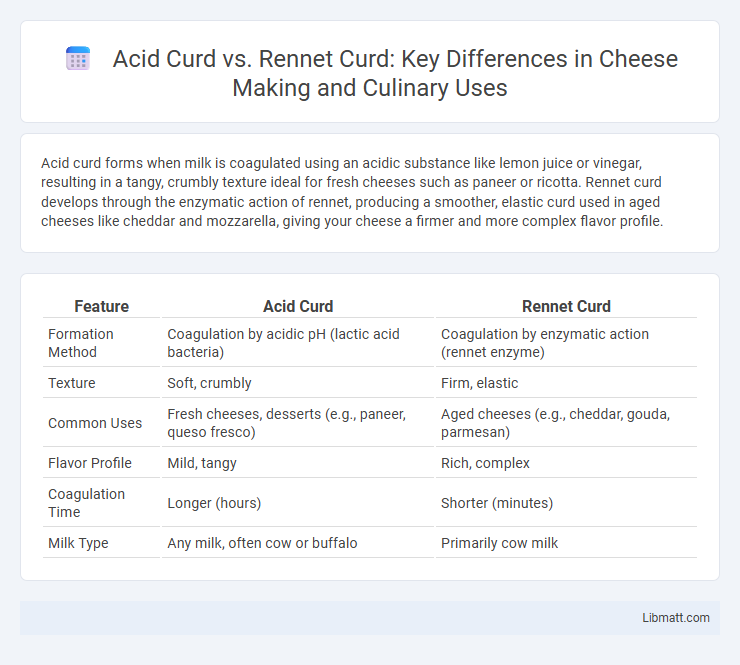Acid curd forms when milk is coagulated using an acidic substance like lemon juice or vinegar, resulting in a tangy, crumbly texture ideal for fresh cheeses such as paneer or ricotta. Rennet curd develops through the enzymatic action of rennet, producing a smoother, elastic curd used in aged cheeses like cheddar and mozzarella, giving your cheese a firmer and more complex flavor profile.
Table of Comparison
| Feature | Acid Curd | Rennet Curd |
|---|---|---|
| Formation Method | Coagulation by acidic pH (lactic acid bacteria) | Coagulation by enzymatic action (rennet enzyme) |
| Texture | Soft, crumbly | Firm, elastic |
| Common Uses | Fresh cheeses, desserts (e.g., paneer, queso fresco) | Aged cheeses (e.g., cheddar, gouda, parmesan) |
| Flavor Profile | Mild, tangy | Rich, complex |
| Coagulation Time | Longer (hours) | Shorter (minutes) |
| Milk Type | Any milk, often cow or buffalo | Primarily cow milk |
Introduction to Acid Curd and Rennet Curd
Acid curd forms when lactic acid bacteria ferment lactose in milk, causing it to coagulate through acidification, resulting in a soft, tangy texture commonly found in products like cream cheese and quark. Rennet curd is produced by adding the enzyme rennet to milk, which specifically cleaves casein proteins and leads to a firmer, more elastic curd used in traditional cheese varieties such as Cheddar and Parmesan. The biochemical processes and microbial agents involved in curd formation significantly influence the texture, flavor, and applications of acid curd versus rennet curd.
What is Acid Curd?
Acid curd forms when milk proteins coagulate due to the addition of an acidic substance like lemon juice or vinegar, causing curdling at a low pH. It retains a softer, more crumbly texture and tangy flavor compared to rennet curd, which relies on enzymes for coagulation. Acid curd is commonly used in recipes requiring fresh cheeses such as paneer or ricotta.
What is Rennet Curd?
Rennet curd forms when an enzyme called rennet coagulates milk, separating it into solid curds and liquid whey, a fundamental process in cheesemaking. Unlike acid curd, which is produced by bacterial fermentation lowering the milk's pH, rennet curd retains a firmer texture and more complex protein structure. This enzymatic coagulation results in varieties like cheddar and mozzarella, prized for their meltability and aging potential.
Key Differences Between Acid and Rennet Curds
Acid curds are formed when milk proteins coagulate due to increased acidity, typically achieved by adding lemon juice or vinegar, resulting in a softer, crumbly texture ideal for fresh cheeses like paneer and cream cheese. Rennet curds develop through enzymatic action using rennet, producing firmer, more elastic curds frequently used in aged cheeses such as cheddar and mozzarella. Understanding these key differences helps you choose the right curd type for your cheese-making or cooking needs based on texture and flavor profiles.
Production Methods Compared
Acid curd is produced by coagulating milk proteins through natural acidification, typically using lemon juice or vinegar, which lowers the pH and causes curd formation. Rennet curd results from adding rennet enzymes to milk, triggering the coagulation of casein proteins and creating a firmer, more elastic texture. Your choice between acid and rennet curd depends on the desired texture and flavor, as acid curds are tangier and softer, while rennet curds are firmer and creamier.
Texture and Flavor Contrast
Acid curd typically exhibits a smooth, creamy texture with a tangy and slightly sour flavor due to the fermentation process involving lactic acid bacteria. Rennet curd, in contrast, has a firmer, more elastic texture with a mild, savory taste resulting from the enzymatic coagulation by rennet. The distinct texture and flavor profiles of acid curd and rennet curd influence their use in various cheese-making applications and culinary dishes.
Common Uses for Acid Curd
Acid curd is commonly used in fresh cheeses like cream cheese, paneer, and farmer's cheese due to its mild flavor and soft texture. It plays a crucial role in recipes that require non-melting cheese, making it ideal for spreads, dips, and baking. Your dishes benefit from acid curd's tangy profile and smooth consistency, enhancing both taste and versatility.
Popular Uses for Rennet Curd
Rennet curd is widely used in the production of aged cheeses like cheddar, Parmesan, and Gouda due to its ability to create a firm texture and rich flavor. Your choice of rennet curd is ideal for making specialty cheeses that require precise coagulation and longer maturation periods. This type of curd is preferred in artisan cheesemaking for its consistency and ability to develop complex taste profiles during aging.
Nutritional Comparison
Acid curd contains higher levels of citric acid and vitamin C, resulting from the fermentation process, while rennet curd is richer in casein proteins and essential minerals like calcium and phosphorus due to enzymatic coagulation. The protein content in rennet curd supports better muscle synthesis, whereas acid curd has a lower fat content and may be easier to digest for individuals with lactose intolerance. Both types of curd provide probiotics that promote gut health, but acid curd offers a slightly enhanced antioxidant profile.
Choosing the Right Curd for Your Recipe
Acid curd and rennet curd differ significantly in texture and taste, impacting your recipe's outcome; acid curd results from bacterial fermentation and offers a tangy flavor with a crumbly texture, ideal for desserts and fresh cheeses. Rennet curd forms through enzyme coagulation, producing a firmer, elastic consistency perfect for aged cheeses and savory dishes. Selecting the right curd hinges on your desired flavor profile and texture, ensuring your culinary creation meets expectations.
Acid Curd vs Rennet Curd Infographic

 libmatt.com
libmatt.com